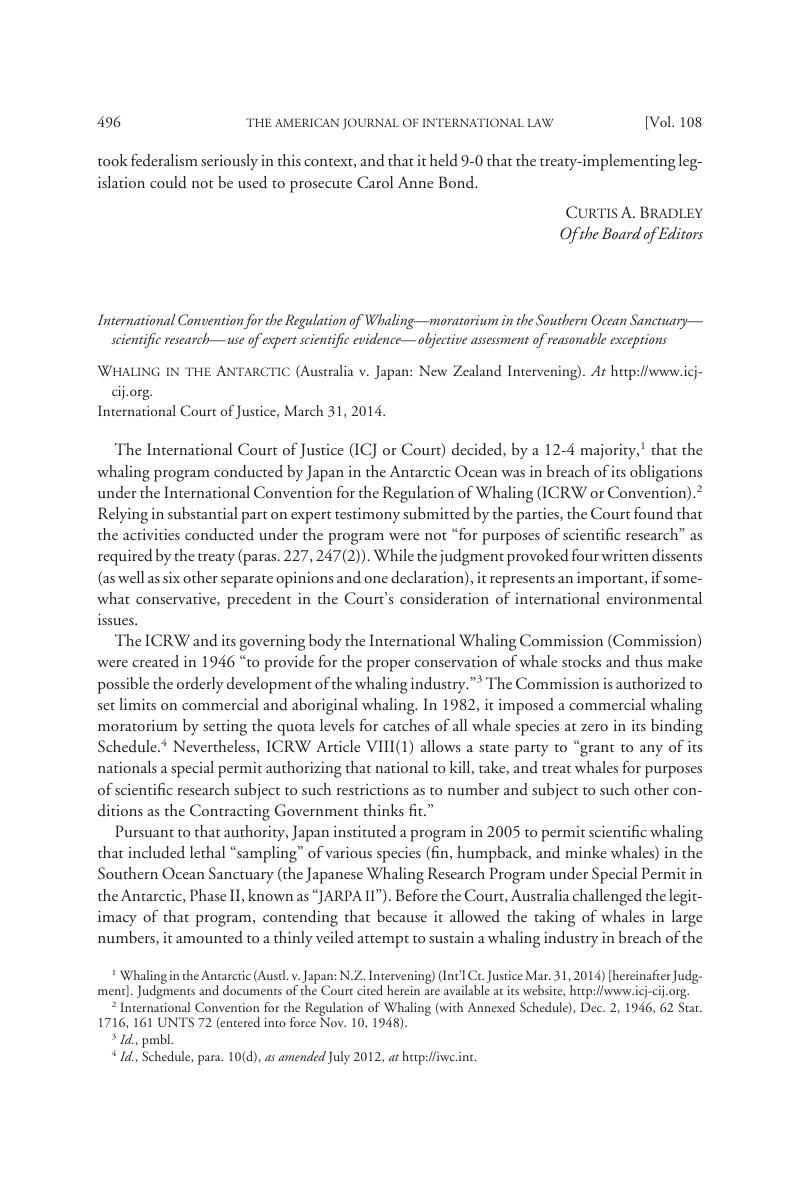Published online by Cambridge University Press: 20 January 2017

1 Whaling in the Antarctic (Austl. v.Japan: N.Z. Intervening) (Int’l Ct. Justice Mar. 31, 2014) [hereinafter Judgment]. Judgments and documents of the Court cited herein are available at its website, http://www.icj-cij.org.
2 International Convention for the Regulation of Whaling (with Annexed Schedule), Dec. 2, 1946, 62 Stat. 1716, 161 UNTS 72 (entered into force Nov. 10, 1948).
3 Id., pmbl.
4 Id., Schedule, para. 10(d), as amended July 2012, at http://iwc.int.
5 1 Memorial of Australia, Whaling in the Antarctic (Austl.v.Japan), paras. 3.15–3.24 (May 9, 2011). According to the Court, approximately 450 minke whales were killed annually from 2006–07 to 2012–13. Judgment, para. 202.
6 1 Counter-Memorial of Japan, Whaling in the Antarctic (Austl. v. Japan), paras. 3.2–3.3, 9.30 (Mar. 9, 2012).
7 The meat of whales caught and killed as part of JARPA II is sold and the proceeds funneled back to JARPA II to fund the program.
8 Vienna Convention on the Law of Treaties, Art. 31(3), May 23, 1969, 1155 UNTS 331.
9 Southern Bluefin Tuna (N.Z. v. Japan; Austl. v. Japan), Case Nos. 3 & 4, Provisional Measures (ITLOS Aug. 27, 1999).
10 Dissenting Opinion [Diss. Op.] of Judge Owada, paras. 32, 33–36 (citing Appellate Body Report, United States—Continued Suspension of Obligations in the EC—Hormones Dispute, WT/DS320/AB/R (Oct. 16, 2008) (adopted Nov. 14, 2008)).
11 See, e.g., Panel Report, European Communities—EC Measures Concerning Meat and Meat Products (Hormones), WT/DS26/R, WT/DS48/R (Aug. 18, 1997), as modified by Appellate Body Report, WT/DS26/AB/R, WT/DS48/AB/R (Jan. 16, 1998) (adopted Feb. 13, 1998); Appellate Body Report, European Communities—Measures Affecting Asbestos and Products Containing Asbestos, WT/DS135/AB/R(Mar. 12,2001) (adopted Apr. 5, 2001); Panel Report, European Communities—Measures Affecting the Approval and Marketing of Biotech Products, WT/DS291/R, WT/DS292/R, WT/DS293/R (Sept. 29, 2006) (adopted Nov. 21, 2006).
12 General Agreement on Tariffs and Trade 1994, Art. XX(b), (g), Apr. 15, 1994, Marrakesh Agreement Establishing the World Trade Organization, Annex 1A, 1867 UNTS 190, reprinted in The Legal Texts: The Results of the Uruguay Round of Multilateral Trade Negotiations 17 (1999) [hereinafter the Legal Texts].
13 Agreement on the Application of Sanitary and Phytosanitary Measures, Art. 2:2, Apr. 15, 1994, Marrakesh Agreement Establishing the World Trade Organization, Annex 1A, 1867 UNTS 493, reprinted in The Legal Texts, supra note 12, at 59.
14 Most instances of ICJ inquiry into scientific research related to evidence of a state’s conducting scientific research as proof of the exercise of sovereignty in boundary cases. In the Gabčíkovo-Nagymaros case, the Court considered the ecological impact of the dam project, though it refrained from adjudicating the battle of experts regarding the exact nature and extent of the environmental impact. Gabčíkovo-Nagymaros Project (Hung./Slovk.), 1997 ICJ Rep. 7, 41–42, 77–78, paras. 54, 140 (Sept. 25).
15 Judge Sebutinde relied on a dictionary definition of “scientific research.” Separate Opinion [Sep. Op.] of Judge Sebutinde, para. 9. Although such an approach does not comport with the requirements of the law of treaties, some international and domestic adjudicators use dictionaries as a starting point to assess the ordinary meaning of a term.
16 Judges differed on their understanding of whether good faith was at issue, whether the majority opinion implicitly addressed good faith, whether Australia had discharged its burden of proof inasmuch as it suggested that Japan had not acted in good faith, and what Japan’s good faith obligation might be. Abraham, J., Diss. Op., paras 28–29; Owada, J., Diss. Op., para. 21; Yusuf, J., Diss. Op., para. 54; Greenwood, J., Sep. Op. para. 29; Sebutinde, J., Sep. Op., para. 18; Cançado Trindade, J., Sep. Op., para. 17; Charlesworth, J. adhoc, Sep. Op., para. 13.
17 Judge Cançado Trindade referred to prior ICJ judgments and other international court opinions to construe the ICRW as a “living instrument,” Cancçado Trindade, J., Sep. Op., paras. 29–33, and he drew on broader international law sources to emphasize its intergenerational equity objective and its precautionary component, id., paras. 41–47, 60–62, 64–71.
18 E.g., id., paras. 42, 47, 79;see also Decker, Alyson, Save the Whales—Save the Whalers—Wait, Just Save the International Whaling Commission: A Fresh Look at the Controversy Surrounding Cultural Claims to Whale, 16 S. Cal. Interdisc. L.J. 253, 274–76 (2006)Google Scholar; see also Harris, A. W., The Best Scientific Evidence Available: The Whaling Moratorium and Divergent Interpretations of Science, 29 Wm. & Mary Envtl. L. & Pol’y Rev. 375, 386–87 (2005)Google Scholar.
19 1 Memorial of Australia, supra note 5, para. 2.67.
20 Disagreements regarding Japan’s whaling practices date to the late 1970s. See, e.g., Don Rothwell, Japanese Whaling: When Diplomacy Fails, Call the ICJ, Jurist, Mar. 3, 2010; John M. Broder, U.S. Leads Bid to Phase out Whale Hunting, N.Y. Times, Apr. 15, 2010, at A1. The stockpile of unsold whale meat is noted in Greenwood, J., Sep. Op., para. 21.
21 Yoko Wakatsuki & Sophie Brown, Japanese Whaling Fleet Set to Sail Despite Recent Ruling, CNN Wire, Apr. 25, 2014, available in LEXIS, News & Business Library, Wire Services Stories File.